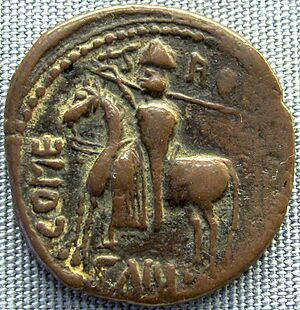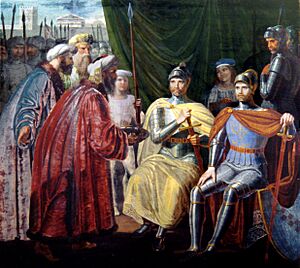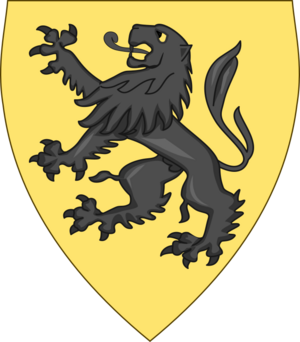Roger I of Sicily facts for kids
Quick facts for kids Roger I |
|
|---|---|

Roger I as he appears on a trifollaro coin minted at Mileto
|
|
| Grand Count of Sicily | |
| Reign | 1071–1101 |
| Predecessor | Robert Guiscard (as Lord) |
| Successor | Simon of Hauteville |
| Born | c.1031 Probably Hauteville-la-Guichard, Duchy of Normandy |
| Died | 22 June 1101 Mileto, Duchy of Apulia and Calabria |
| Burial | Benedictine Abbey of the Holy Trinity, Mileto |
| Spouse | Judith d'Évreux Eremburga of Mortain Adelaide del Vasto |
| Issue | illegitimately: Jordan William (unsure) Geoffrey, Count of Ragusa (unsure) by Judith d'Évreux: Flandina Matilda Adelisa Emma by Eremburga of Mortain: Mauger, Count of Troina Muriel Constance, Queen of Germany Felicia, Queen of Hungary Judith Sibylla by Adelaide del Vasto: Simon, Count of Sicily Matilda, Countess of Alife King Roger II of Sicily Maximilla |
| House | Hauteville |
| Father | Tancred of Hauteville |
| Mother | Fredisenda |
Roger I (born around 1031 – died June 22, 1101) was a powerful Norman leader. He was often called “Roger Bosso” or “Grand Count Roger”. He became the very first Grand Count of Sicily, ruling from 1071 to 1101.
Roger was part of the House of Hauteville, a famous family of Norman warriors. He led many military trips to fight against the Muslim rulers of Sicily, starting in 1061. His brother, Robert Guiscard, who was the Duke of Apulia, gave him control over part of Sicily in 1071. By 1090, Roger had taken over the entire island. In 1091, he also conquered the island of Malta.
The lands Roger conquered later joined with the Duchy of Apulia in 1127. This new, larger area became the Kingdom of Sicily in 1130. Roger's family continued to rule Sicily until 1194.
Contents
Early Life of Roger I
Roger was born in Normandy, a region in France. He likely came from the village of Hauteville-la-Guichard, where his father was the local lord. He was the youngest son of Tancred of Hauteville and his second wife, Fressenda. Not much is known about Roger's early life or his brothers before they traveled to southern Italy.
Arrival in Italy and Calabria
Roger arrived in Southern Italy as a young man in the summer of 1057. A monk named Goffredo Malaterra wrote about Roger. He described him as a very handsome young man, tall and graceful. Roger was also a good speaker and a smart planner. He was friendly and cheerful, but also strong and brave in battle.
Roger came to Italy with his brother, Robert Guiscard. Their older half-brother, Humphrey of Hauteville, had died. Robert inherited the main title of Count of Apulia. Roger became his brother's helper and was given control of the newly conquered area of Calabria.
For a while, Roger lived like a leader of a small army in his castle at Scalea. In 1062, Roger and Robert made a deal. They decided to share their conquered lands, with each brother getting half of every castle and town in Calabria. Roger then set up his main home in Mileto. In December 1061, he married Judith d'Évreux, who was the daughter of a French count.
The two brothers then captured Reggio, the last city in Calabria still controlled by the Byzantine Greeks. This was a long and tough fight. They also took the fort of Squillace. From their strongholds in Calabria, Roger and Robert began to plan their next big goal: conquering Sicily, which was then ruled by Muslims.
Roger's Expeditions to Sicily
At this time, Sicily was under Muslim rule. Most of the people living there were Byzantine Greek Christians. The Muslim leaders on the island had become quite independent from the main ruler in Tunis.
Roger and Robert found a reason to invade Sicily when Ibn al-Thumna, a Muslim leader from Catania, asked for their help. He was fighting against his brother-in-law, Ibn al-Hawwas, who ruled Agrigento. In May 1061, the brothers crossed from Reggio and quickly captured Messina. From there, they moved forward easily, reaching Castrogiovanni.
Roger and Robert had a disagreement, and Roger left Sicily for a short time. But he soon returned with his wife, Countess Judith d'Évreux. They came to protect the people of Troina, who were being threatened by Muslims. The Greek farmers welcomed Roger. However, while Roger was taking Nicosia, the Greeks tried to capture his wife, who was not well-guarded. Roger had to rush back to save her. Even though the Muslims and Greeks joined forces, Roger defeated them and continued his advance.
In June 1063, Roger won a famous victory against a Muslim army at the Battle of Cerami. While some stories about the battle are exaggerated, we know that Roger's nephew, Serlo II of Hauteville, led a smaller army in the fight. Legend says that Saint Michael Archangel, shining brightly, appeared and guided the Christian soldiers to victory.
After gathering an army of 500 soldiers, Roger tried to capture Palermo. But after three months with little success, he decided to give up for a while. His power continued to grow, and he won another important battle at Battle of Misilmeri in 1068. He defeated a much larger Islamic army there.
After Duke Robert captured Bari in 1070, which was the last Byzantine area in Italy, he focused on Sicily. He helped Roger conquer the island's main cities. In 1071, Roger was given the title of Grand Count of Sicily. Robert kept Messina and Val Demone for himself. The two brothers then surrounded Palermo from different sides. The Muslims defended the city for five months. Then, Robert managed to open a gate for Roger to enter. On January 10, 1072, Palermo was finally captured. Only a few cities remained for Sicily to be fully controlled.
When Robert died in 1085, Roger was the oldest male in the family. He had to go back to Apulia to help settle a disagreement between Robert's sons. In exchange for supporting Robert's son, Roger Borsa, Roger I got to keep Calabria for himself. He was later given Palermo in 1091.
Back in Sicily, Roger went to war with Benavert, the Muslim leader of Syracuse and Noto. In May 1086, Roger and his son Jordan marched to Syracuse. In the middle of the night, they attacked the Muslim ships by surprise. Roger bravely jumped onto Benavert’s ship. The Muslim leader, scared, tried to jump to another boat but fell into the water and drowned because of his heavy armor. Benavert’s death caused confusion, and in October, Syracuse surrendered due to hunger.
After Syracuse, Agrigento fell to the Normans in 1087, along with Castrogiovanni. Both were held by the Muslim leader Kamut. During the siege of Butera in 1089, Roger learned that Pope Urban II had arrived in Troina. He left his men to continue the siege and went to meet the Pope. Roger treated the Pope with great respect and received valuable gifts. He then returned to Butera, which fell in 1090. When he arrived in Mileto to celebrate his marriage to Adelaide del Vasto, he received messengers from Noto. They asked for peace and surrendered to Sicily. Finally, in 1091, Roger controlled the entire island.
Roger's rule in Sicily was very strong, even more so than Robert Guiscard's rule in Italy. Many Lombards and Normans moved to the island. This meant that Latin Christianity slowly replaced the Greek Byzantine traditions. Roger did not create large, undivided land areas for his nobles. All his Norman, French, and Italian nobles owed their lands and loyalty directly to him. Because of this, there were no major rebellions against Roger.
Conquest of Malta
In 1091, Roger decided to conquer Malta to prevent attacks from North Africa. He set sail with his fleet, and his ship reached the island before the others. When he landed, the few defenders quickly retreated. The next day, Roger marched to the capital city, Mdina. He discussed terms with the local Muslim judge, called a qadi. They agreed that the islands would pay taxes to Roger. The qadi would continue to govern the islands.
As part of the agreement, many Greek and other Christian prisoners were freed. They cheered for Roger, chanting "Kyrie eleison" (Lord, have mercy). Roger left the islands with many people who wanted to join him. So many were on his ship that it almost sank, according to the writer Geoffrey Malaterra. Later stories made this invasion seem even more heroic. Legends say that Roger gave the Maltese people their red and white flag by cutting a piece from his own banner. A special mass is held once a year at the Cathedral of Mdina to remember Roger. This honors his role in freeing Maltese Christians from Muslim rule.
Roger's Rule in Sicily
As the supreme political leader, Roger also gained control over the church on the island. The Pope supported Roger because he had taken Sicily back from the Greeks and Muslims. In 1098, the Pope gave Roger and his family the special power to act as the Pope's representative (Apostolic Legate) on the island. Roger created new Latin Christian bishoprics (church districts) in places like Syracuse and Girgenti. He personally chose the bishops for these areas. He also made the archbishopric of Palermo a Catholic center.
Most of these new church leaders were not Norman. Roger allowed Arabs and Greeks to practice their religions freely. He even helped build more than twelve Greek monasteries in the Val Demone region. In the cities, Muslims were allowed to keep their mosques, their judges (qadis), and their freedom to trade. However, in the countryside, many Muslims became serfs, meaning they were tied to the land. Roger also used many Muslim soldiers in his army. Saint Anselm, a famous church leader, visited Roger in 1098 and saw countless "brown tents of the Arabs" in his army. Despite this, the Latin Christian influence grew stronger as many Lombards and other Italians moved to the island after the conquest. Roger's conquest of Sicily was a key event that led to the decline of Muslim power in the western Mediterranean Sea.
Death and Succession
Roger I died on June 22, 1101, in Mileto. He was buried at the Benedictine Abbey of the Holy Trinity. This abbey was destroyed in an earthquake in 1783. Its ruins can still be seen today at the Mileto Antica archaeological park.
After Roger's death, his son, Simon of Hauteville, became the Count of Sicily. Simon's mother, Adelaide del Vasto, acted as his regent, meaning she ruled for him because he was too young. Simon died on September 28, 1105, at the age of 12. The title of count then passed to his younger brother, Roger II of Sicily. Adelaide continued to rule as regent for Roger II, as she was also his mother.
Roger's Family and Children
Roger had three sons whose mothers are not fully clear:
- Jordan (born around 1060 – died 1092), a military commander, who died before his father.
- A son named William, whose mother is uncertain.
- Geoffrey (died around 1120), who became Count of Ragusa. His mother is also uncertain. He could not inherit the main title because he had leprosy.
Roger's first marriage was in 1062 to Judith d'Évreux. They had only daughters:
- Flandina, who first married Hugh of Jarzé. After he died, she married Henry del Vasto, who was the brother of Roger's third wife, Adelaide.
- Matilda (born around 1062 – died before 1094), who first married Robert, Count of Eu. She later married Raymond IV, Count of Toulouse in 1080.
- Adelisa (died before 1096), who married Henry, Count of Monte Sant'Angelo in 1083.
- Emma (born around 1070 – died 1120), who was briefly engaged to Philip I of France. She married William VI, Count of Auvergne and later Rudolf, Count of Montescaglioso.
In 1077, a year after Judith died, Roger married for a second time to Eremburga of Mortain. Their children were:
- Mauger (born around 1080 – died around 1100), who was Count of Troina.
- Muriel (died 1119), who married Josbert de Lucy.
- Constance (1082 – died after 1135), who married Conrad II of Italy, the son of Henry IV, Holy Roman Emperor.
- Felicia (died 1102), who married Coloman, King of Hungary.
- Judith (died 1136), who married Robert I, Count of Conversano.
- Sybilla, who married Robert, the son of Robert I, Duke of Burgundy.
Eremburga died in 1087. Roger then married for a third time to Adelaide del Vasto. She was the sister of his son-in-law, Henry del Vasto. Roger and Adelaide's children were:
- Matilda (died before 1094), who married Ranulf II, Count of Alife.
- Simon (1093–1105), who became Count of Sicily.
- Roger II (1095–1154), who became King of Sicily.
- Maximilla (also called Matilda, died after 1137), who married Ildebrandino VI Aldobrandeschi.
One of Roger's daughters, also named Matilda, married Guigues III, Count of Albon.




